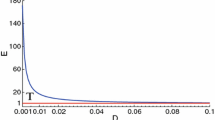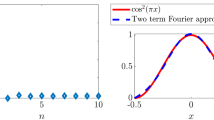Abstract
There are numerous examples of morphogen gradients controlling long range signalling in developmental and cellular systems. The prospect of two such interacting morphogens instigating long range self-organisation in biological systems via a Turing bifurcation has been explored, postulated, or implicated in the context of numerous developmental processes. However, modelling investigations of cellular systems typically neglect the influence of gene expression on such dynamics, even though transcription and translation are observed to be important in morphogenetic systems. In particular, the influence of gene expression on a large class of Turing bifurcation models, namely those with pure kinetics such as the Gierer–Meinhardt system, is unexplored. Our investigations demonstrate that the behaviour of the Gierer–Meinhardt model profoundly changes on the inclusion of gene expression dynamics and is sensitive to the sub-cellular details of gene expression. Features such as concentration blow up, morphogen oscillations and radical sensitivities to the duration of gene expression are observed and, at best, severely restrict the possible parameter spaces for feasible biological behaviour. These results also indicate that the behaviour of Turing pattern formation systems on the inclusion of gene expression time delays may provide a means of distinguishing between possible forms of interaction kinetics. Finally, this study also emphasises that sub-cellular and gene expression dynamics should not be simply neglected in models of long range biological pattern formation via morphogens.
Similar content being viewed by others
References
Alberts, B., Johnson, A., Walter, P., Lewis, J., Raff, M., Roberts, K., 2002. Molecular Biology of the Cell, 5th edn. Garland, New York.
Baker, R.E., Gaffney, E.A., Maini, P.K., 2008. Partial differential equations for self-organization in cellular and developmental biology. Nonlinearity 21, R251–R290.
Bard, J., Lauder, I., 1974. How well does Turing’s theory of morphogenesis work? J. Theor. Biol. 45, 501–531.
Baron, M., Aslam, H., Flasza, M., et al., 2002. Multiple levels of notch signal regulation (review). Mol. Membr. Biol. 19, 27–38.
Beguinot, L., Lyall, R.M., Willingham, M.C., Pastan, I., 1984. Down-regulation of the epidermal growth factor receptor in kb cells is due to receptor internalization and subsequent degradation in lysosomes. Proc. Natl. Acad. Sci. 81, 2384–2388.
Chen, Y., Schier, A., 2002. Lefty proteins are long-range inhibitors of squint-mediated nodal signaling. Curr. Biol. 12, 2124–2128.
Crampin, E.J., Gaffney, E.A., Maini, P.K., 1999. Reaction and diffusion on growing domains: Scenarios for robust pattern formation. Bull. Math. Biol. 61, 1093–1120.
Eldar, A., Dorfman, R., Weiss, D., Ashe, H., Shilo, B.Z., Barkai, N., 2002. Robustness of the BMP morphogen gradient in drosophila embryonic patterning. Nature 419, 304–308.
Entchev, E.V., Schwabedissen, A., Gonzalez-Gaitan, M., 2000. Gradient formation of the TGF-β homolog Dpp. Cell 103, 981–991.
Fischer, J.A., Eun, S.H., Doolan, B.T., 2006. Endocytosis, endosome trafficking, and the regulation of drosophila development. Annu. Rev. Cell Dev. Biol. 22, 181–206.
Gaffney, E.A., Monk, N.A.M., 2006. Gene expression time delays and Turing pattern formation systems. Bull. Math. Biol. 68, 99–130.
Gierer, A., Meinhardt, H., 1972. A theory of biological pattern formation. Kybernetik 12, 30–39.
Harris, M.P., Williamson, S., Fallon, J.F., Meinhardt, H., Prum, R.O., 2005. Molecular evidence for an activator–inhibitor mechanism in development of embryonic feather branching. Proc. Natl. Acad. Sci. USA 102(33), 11734–11739.
Iratini, R., Yan, Y.T., Chen, C., 2002. Drap1 gastrulation by the transcriptional corepressor inhibition of excess nodal signaling during mouse. Science 298, 1996–1999.
Jing, X.H., Zhou, S.M., Wang, W.Q., Chen, Y., 2006. Mechanisms underlying long- and short-range nodal signaling in zebrafish. Mech. Dev. 123, 388–394.
Juan, H., Hamada, H., 2001. Roles of nodal-lefty regulatory loops in embryonic patterning of vertebrates. Genes Cells 6, 923–930.
Jung, H.S., Francis-West, P.H., Widelitz, R.B., Jiang, T.X., Ting-Berreth, S., Tickle, C., Wolpert, L., Chuong, C.M., 1998. Local inhibitory action of BMPs and their relationships with activators in feather formation: Implications for periodic patterning. Dev. Biol. 196, 11–23.
Kimmel, C.B., Ballard, W.W., Kimmel, S.R., Ullmann, B., Schilling, T.F., 1995. Stages of embryonic development of the zebrafish. Dev. Dyn. 203, 253–310.
Koch, A.J., Meinhardt, H., 1994. Biological pattern formation: from basic mechanisms to complex structures. Rev. Mod. Phys. 66(4), 1481–1507.
Krezel, L.S., 2003. Vertebrate development: Taming the nodal waves. Curr. Biol. 13, R7–R9.
Lewis, J., 2003. Autoinhibition with transcriptional delay: A simple mechanism for the zebrafish somitogenesis oscillator. Curr. Biol. 13, 1398–1408.
Miura, T., Maini, P.K., 2004. Speed of pattern appearance in reaction-diffusion models: Implications in the pattern formation of limb bud mesenchyme cells. Bull. Math. Biol. 66, 627–649.
Miura, T., Shiota, K., 2000. Extracellular matrix environment influences chondrogenic pattern formation in limb bud micromass culture: Experimental verification of theoretical models. Anat. Rec. 258, 100–107.
Morton, K.W., Mayers, D.F., 1994. Numerical Solution of Partial Differential Equations. Cambridge University Press, Cambridge.
Murray, J.D., 1993. Mathematical Biology, 2nd edn. Springer, Berlin.
Page, K.M., Monk, N.A.M., Maini, P.K., 2007. Speed of reaction diffusion in embryogenesis. Phys. Rev. E 76, 011902.
Piddini, E., Vincent, J., 2003. Modulation of developmental signals by endocytosis: different means and many ends. Curr. Cell Biol. 15, 474–481.
Rauch, E.M., Millonas, M.M., 2004. The role of trans-membrane signal transduction in Turing-type cellular pattern formation. J. Theor. Biol. 226, 401–407.
Roy, C.L., Wrana, J.L., 2005. Clathrin- and nonclathrin-mediated endocytic regulation of cell signaling. Nat. Rev. Mol. Cell Biol. 6, 112–126.
Schier, A.F., 2003. Nodal signaling in verterbrate development. Rev. Cell Dev. Biol. 19, 589–621.
Schnakenberg, J., 1979. Simple chemical reaction systems with limit cycle behaviour. J. Theor. Biol. 81, 389–400.
Segel, L.A., Jackson, J.L., 1972. Dissipative structure. an explanation and an ecological example. J. Theor. Biol. 37, 545–559.
Sorkin, A., von Zastrow, M., 2002. Signal transduction and endocytosis: close encounters of many kinds. Nat. Rev. Mol. Cell Biol. 3, 600–614.
Stoscheck, C.M., Carpenter, G., 2002. Down-regulation of egf receptors: direct demonstration of receptor degradation in human fibroblasts. J. Cell Biol. 98, 1048–1053.
Tennyson, C.N., Klamut, H.J., Worton, R.G., 1995. The human dystrophin gene requires 16 hr to be transcribed and is contranscriptionally spliced. Nat. Gen. 9, 184–190.
Turing, A., 1952. The chemical basis of morphogenesis. Philos. Trans. R. Soc. Lond. B 237, 37–72.
Varea, C., Hernandez, D., Barrio, R.A., 2007. Soliton behaviour in a bistable reaction diffusion model. J. Math. Biol. 54, 797–813.
Veflingstad, S.R., Plahte, E., Monk, N.A.M., 2005. Effect of time delay on pattern formation: Competition between homogenisation and patterning. Physica D 207, 254–271.
Wells, A., Welsh, J.B., Lazar, C.S., Wiley, H.S., Gill, G.N., Rosenfeld, M.G., 1990. Ligand-induced transformation by a noninternalizing epidermal growth factor receptor. Science 247, 962–964.
Author information
Authors and Affiliations
Corresponding author
Rights and permissions
About this article
Cite this article
Seirin Lee, S., Gaffney, E.A. & Monk, N.A.M. The Influence of Gene Expression Time Delays on Gierer–Meinhardt Pattern Formation Systems. Bull. Math. Biol. 72, 2139–2160 (2010). https://doi.org/10.1007/s11538-010-9532-5
Received:
Accepted:
Published:
Issue Date:
DOI: https://doi.org/10.1007/s11538-010-9532-5




